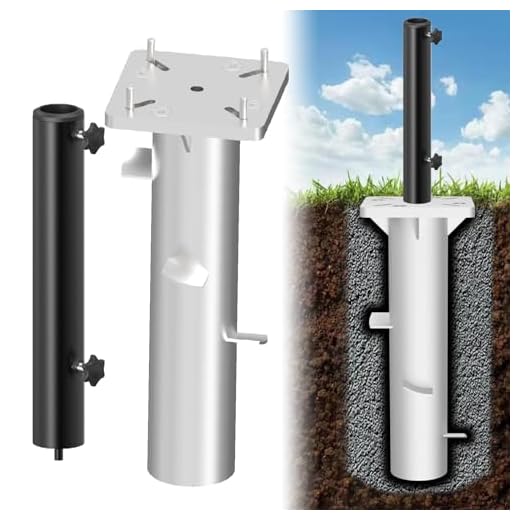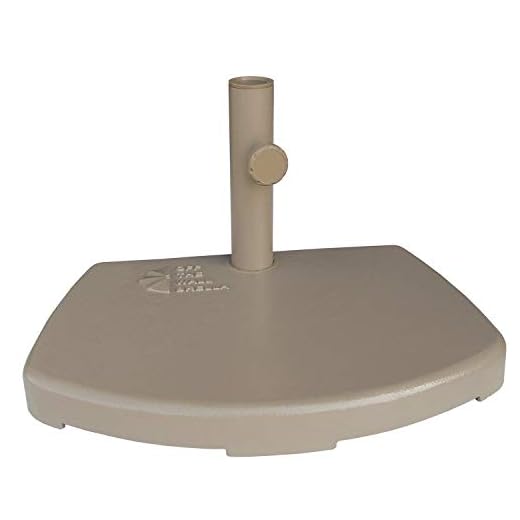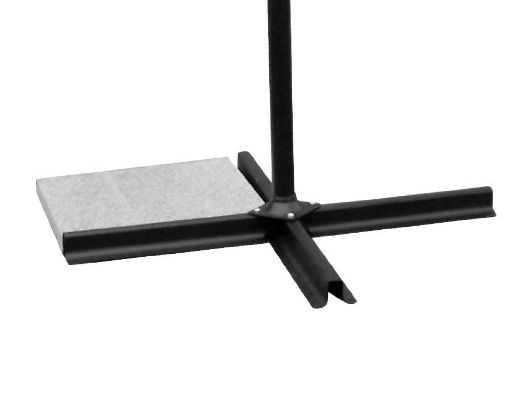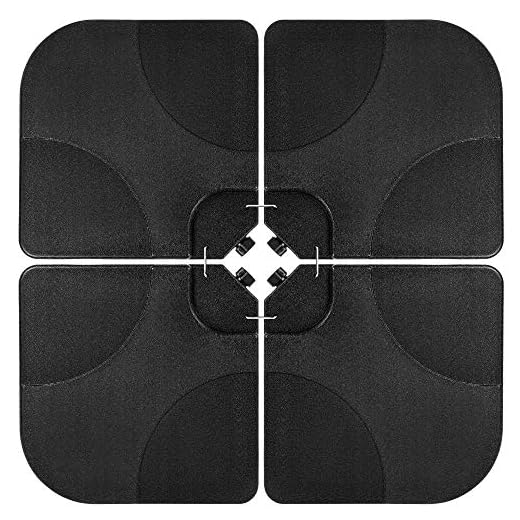




Using heavy weights is the most reliable strategy to stabilize your freestanding canopy. This article provides detailed guidance on various methods and materials that ensure your structure remains grounded even in windy conditions. From sandbags to concrete blocks, we explore the most effective options available.
This information is particularly beneficial for homeowners, event planners, and anyone who enjoys outdoor gatherings. Understanding how to properly anchor your canopy will enhance safety and enjoyment during sunny days or unexpected gusts of wind.
We will discuss a variety of anchoring solutions, including DIY options and commercially available products. With the right approach, you can enjoy your outdoor space without the worry of your canopy tipping over or being blown away.
Best Way to Weigh Down Cantilever Umbrella
Utilizing heavy base weights is an effective solution for stabilizing a freestanding shade structure. These weights should be made from durable materials, such as concrete or steel, to provide the necessary support against wind and other forces. Make sure that the total weight is sufficient to prevent tipping or excessive movement.
Another option involves using sandbags. By filling sturdy bags with sand, you can create a flexible and adjustable support system. This approach allows for easy relocation and can be tailored based on the specific weather conditions or the environment where the structure is placed.
Additional Recommendations
Consider the following methods to further enhance stability:
- Ground Anchors: Secure the structure to the ground with anchors. This method is particularly useful in areas prone to high winds.
- Water-Filled Bases: Use bases that can be filled with water. This solution is convenient as it allows for easy transport when empty.
- Weighted Plates: Attach or place weighted plates around the base. These can be designed to match the aesthetics of the structure.
Always assess the local weather patterns before deciding on the right method. For instance, in regions with frequent gusts, a combination of weights and ground anchors may provide optimal security.
Choosing the Right Base Material for Stability
When selecting a foundation for an outdoor shade structure, the material plays a significant role in ensuring stability and durability. Concrete bases are often preferred due to their weight and resistance to weather conditions. They can effectively prevent tipping, even in windy environments.
Another option is plastic or resin bases, which can be filled with sand or water for added weight. These materials are lightweight and portable, making them easy to move and store when not in use. However, their performance may vary based on the amount of weight they can hold.
Factors to Consider
- Weight: Heavier materials generally provide more stability. Consider how much weight is necessary based on the size of the structure.
- Durability: Choose materials that can withstand outdoor elements, such as rust or corrosion.
- Portability: If mobility is a priority, lighter materials may be preferable, but ensure they can still provide adequate support.
- Maintenance: Some materials require more upkeep than others. Evaluate the long-term care needed for your selected base.
Ultimately, the right choice depends on individual needs and environmental factors. Assessing the location and expected weather conditions will guide the decision-making process effectively.
Optimal Weight Distribution Techniques for Umbrella Safety
To ensure stability and safety, distributing weight effectively is paramount. Using heavier materials at the base provides a solid foundation that can withstand wind gusts and shifting weather conditions.
Consider integrating sandbags or weighted plates, as they offer versatility and can be adjusted easily according to specific requirements. Placing these weights at the outer edges of the support structure enhances balance and minimizes the risk of tipping.
Strategies for Effective Weight Distribution
Implementing specific techniques can greatly improve the stability of your setup:
- Layering Materials: Utilize multiple layers of different materials to achieve optimal weight. Start with a heavier base layer, followed by lighter materials.
- Uniform Placement: Ensure that weights are uniformly distributed around the base to maintain equilibrium and prevent tilting.
- Adjustable Weights: Use adjustable weights that can be easily added or removed based on weather conditions.
Additionally, consider the shape and design of the structure. A wider base can enhance stability, while a more streamlined design can help reduce wind resistance.
In conclusion, focusing on effective weight distribution techniques will enhance safety and prolong the life of your outdoor shade solution. By carefully considering material choices and placement strategies, one can create a secure and functional space.
DIY Solutions for Custom Umbrella Weights
Creating your own weights for outdoor shade structures can be both practical and cost-effective. By utilizing materials readily available at home or in local stores, you can ensure stability without relying on expensive commercial options.
One effective approach is to use concrete. Mixing a batch of concrete in a mold allows you to create custom shapes that fit your specific needs. Consider using plastic buckets or old containers as molds. Once the concrete sets, you can place these weights around the base of your shade structure to provide the necessary support.
Alternative Materials for Stability
In addition to concrete, there are other materials that can serve as effective anchors. Sandbags are a popular choice due to their weight and flexibility. Simply fill durable bags with sand and arrange them around the base. For a more decorative option, consider filling planters with gravel or rocks, which can also enhance your outdoor space.
Water-filled bases are another option. Large containers or barrels can be filled with water and placed at the base. This method allows for easy adjustments, as you can empty the containers and move them when necessary.
- Concrete blocks: Stackable and easy to obtain.
- Bricks: Utilize leftover bricks from construction projects.
- Pavers: Heavy and can be arranged to suit your design.
For those seeking a more creative solution, consider crafting decorative weights using PVC pipes. Cut the pipes to desired lengths, fill them with concrete, and cap the ends. These can be painted or decorated to match your outdoor décor.
Always ensure that the materials used provide adequate stability for your specific setup. Regularly check the condition of your weights, especially after storms or high winds, to maintain safety and functionality.
Final Thoughts on Comparing Commercial Weights for Patio Canopies
Choosing the right commercial weights for your patio canopies is crucial for stability and safety. Opt for options that provide adequate support based on the size and design of your structure. A common recommendation is to select weights that are at least 50-100 pounds for larger models to ensure they remain secure in windy conditions.
Consider the material and design of the weights as well. Heavy-duty plastic or concrete options are often preferred for their durability and resistance to rust. Furthermore, look for weights that can easily be filled with water or sand, allowing for convenient adjustments according to weather conditions.
Comparison Summary
| Weight Type | Material | Weight (lbs) | Features |
|---|---|---|---|
| Square Base | Concrete | 100 | Stable, weather-resistant |
| Water-Filled | Plastic | 50 | Lightweight, easy to transport |
| Sand-Filled | Fabric | 75 | Flexible, customizable weight |
| Round Base | Metal | 80 | Durable, rust-resistant |
In conclusion, selecting the appropriate weights involves balancing stability, portability, and material durability. Analyze your specific needs and environment before making a purchase to ensure your patio canopy remains securely anchored.
Best way to weigh down cantilever umbrella
Features
| Part Number | SKY3257 |
| Model | SKY3257 |
| Color | Black |
| Size | 4-Piece |
Features
| Part Number | CY-YM-CU |
| Model | CY-YM-CU |
| Color | Anchor with sleeve |
Features
| Part Number | FUB41B |
| Model | FUB41B |
| Color | Black |
| Release Date | 2023-12-22T00:00:01Z |
Features
| Part Number | CCB-2-40 |
| Model | CCB-2 |
| Warranty | 1 Year Repair or Replacement |
| Color | Champagne |
Features
| Part Number | SKY5897 |
| Model | SKY5897 |
| Color | Black |
| Size | Set of 1 |
Video:
FAQ:
What materials are best for weighing down a cantilever umbrella?
When choosing materials to weigh down a cantilever umbrella, options include concrete weights, sandbags, or specially designed umbrella bases. Concrete weights are durable and can provide significant stability, while sandbags offer flexibility and ease of transport. Umbrella bases specifically designed for cantilever umbrellas often have a hollow structure that can be filled with water or sand for added weight.
How much weight do I need to secure a cantilever umbrella effectively?
The amount of weight required to secure a cantilever umbrella depends on its size and the wind conditions in your area. Generally, a base weight of at least 100-150 pounds is recommended for smaller umbrellas, while larger models may need 200 pounds or more. Always check the manufacturer’s specifications for guidance on weight requirements.
Can I use water-filled bases for my cantilever umbrella?
Yes, water-filled bases are a popular choice for cantilever umbrellas. These bases can be easily filled and emptied, making them convenient for seasonal use. However, it’s important to ensure that the base is securely sealed to prevent leaks, and to check for stability regularly, especially in windy conditions.
What are some DIY options for weighing down a cantilever umbrella?
For a DIY approach, consider using concrete blocks, bricks, or heavy-duty plastic containers filled with sand or gravel. You can stack these materials around the base of the umbrella for added support. Just ensure that the setup is stable and won’t tip over easily, especially in windy weather.
How can I ensure my cantilever umbrella stays stable in windy conditions?
To keep your cantilever umbrella stable in windy conditions, use a combination of a heavy base and additional weights if necessary. Position the umbrella away from direct wind paths and consider using wind-vented canopies, which allow air to flow through, reducing the risk of the umbrella being lifted or toppled. Regularly check the stability and make adjustments as needed based on changing weather conditions.








